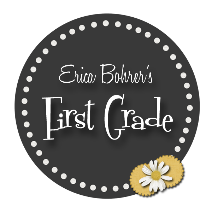I'm linking up with Doodle Bugs for Five for Friday again! I love looking back on my week and finding great ideas from inspirational teachers.
1. I spent Presidents' Day afternoon at the Contemporary Jewish Museum wandering around the Ezra Jack Keats exhibit. No pictures were allowed inside the gallery, but let me tell you - it was AMAZING! Did you know Ezra Jack Keats paved the way for African American protagonists in children's literature? The Snowy Day was published at the height of the 1960s civil rights movement and it was the first book of its kind. This book about a young child enjoying the snow changed children's literature forever. Several letters written to Keats and his publishing house were on display, including a letter from poet Langston Hughes. It was inspiring to see his original artwork for his children's books on display.
2. I spent one night this week with a group of entrepreneurs, investors and fellow educators at an Ed Tech Meet Up. The purpose of the Meet Up was to bridge the gap between technologists and educators. I met several incredible people in both the tech and education world. Some exciting things are happening in education and I'm excited to be in the midst of it all. I was able to interact with representatives from The Minerva Project, Ed Surge, Citizen Schools, Caliber Schools, IXL (a great math website), Learn Sprout, University Now and a few others. Check out the view from our meeting place. Have I mentioned how much I love San Francisco?

3. Okay, maybe I should tell you about my week inside my actual classroom. My students have been working hard on their circle stories (in the style of Laura Numeroff) during writing workshop time. Look at all those proofreading marks on the left! And, skipping lines to make room for revisions! I love it. Look at the notebook on the right, "If You Give Miss Schneider Some Starbucks!" Hilarious. We'll publish them next week on fancy paper after spending some time revising and proofreading with partners.
4. Inflectional endings are tricky. When do you just add -ing? When do you only add -ed? When do you drop the final e? When do you double the last consonant? What if the base word has a short vowel sound? So many possibilities! We went on an inflectional endings scavenger hunt to seek out some of these examples in our everyday reading. Students were instructed to look in books and magazines to find verbs with -ing and -ed inflectional endings. I uploaded the simple template we used to Teachers Pay Teachers. Feel free to downloaded it for free here! Be sure to leave me some feedback if you use it with your class. I hope to have more resources up on TPT in the future.
5. We are studying the miracles of Jesus in religion right now. We learned about Jesus healing a blind man this week. We learned that there are many resources to help blind people in today's modern world. They had so much fun taking a field trip around the school to "read" some Braille. When we returned to the classroom, each student received a Braille alphabet and made up his/her own message for a friend to translate.

Can I leave you with one more picture? This is what I was greeted by at the end of one of my runs this week - a beautiful sunset over the Pacific Ocean. I'm spoiled!
Have a great weekend,
Heather














































